
A lip piercing is a type of body piercing that penetrates the lips or the area surrounding the lips, which can be pierced in a variety of ways.

A clitoral hood piercing is a female genital piercing through the clitoral hood surrounding the clitoris. In addition to being an adornment, a clitoral hood piercing can enhance sexual pleasure during masturbation, foreplay and intercourse. In an empirical study at the University of South Alabama, the authors reported a positive relationship between vertical clitoral hood piercings and desire, frequency of intercourse, and sexual arousal. There are two main types of clitoral hood piercing: the vertical clitoral hood (VCH) piercing and the horizontal clitoral hood (HCH) piercing. As the names indicate, the difference is in the direction the piercing is oriented in the skin above the clitoris. Neither of these piercings penetrates the clitoris itself, although in common parlance they are sometimes called "clit" piercings. The deep hood piercing is a variation of the clitoral hood piercing that passes deeper through the clitoral hood.

Play piercing, needle play, or recreational acupuncture is body piercing done for the purpose of enjoying the experience rather than producing a permanent body decoration. Needles, sharpened bones, or other tools used in play piercing are removed from the body when the episode is complete, allowing the wounds to heal. Those who engage in play piercing may do so for self-expression, imitating tribal rituals, spiritual self-discovery, sexual pleasure, or entertainment.

An eyebrow piercing is a vertical surface piercing, wherein a twelve to eighteen gauge cannula needle is inserted through the bottom of the eyebrow and exits through the top of the eyebrow to permit insertion of jewelry. Those performing the piercing may use a pennington clamp to better guide the needle through the skin. A curved barbell is the most common jewelry inserted post-piercing.

A dydoe is a type of male genital piercing that passes through the ridge of the glans on the head of the penis. They are often done in pairs. Less often, a "king's crown" is where several dydoes are placed around the head of the penis. The jewelry is usually a 12 gauge, straight barbell with a ball on either end, although a ring may be used at a higher chance of rejection. A deep dydoe is one that uses a longer barbell and exits near the tip of the penis.

Genital piercing is a form of body piercing that involves piercing a part of the genitalia, thus creating a suitable place for wearing different types of jewellery. Nevertheless, the term may also be used pars pro toto to indicate all body piercings in the area of the anus, perineum, penis, scrotum, and vulva, including piercings such as anal, guiche, and pubic that do not involve perforation of genitalia. Genital piercings can be done regardless of sex, with various forms of piercings available. The main motive is beautification and individualization; in addition, some piercings enhance sexual pleasure by increasing stimulation. Pre-modern genital piercings is most culturally widespread in Southeast Asia, where it has been part of traditional practice since ancient times. Records of genital piercing are found in the Kama Sutra.
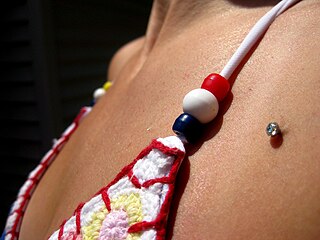
Transdermal implants, or dermal piercings, are a form of body modification used both in a medical and aesthetic context that, in contrast to subdermal implants, consist of an object placed partially below and partially above the skin, thus implanted transdermal. Two techniques are prevalent using post-like and microdermal implants respectively.

A hafada piercing is a surface piercing anywhere on the skin of the scrotum. Piercings on the scrotal raphe or "seam" of the scrotum are common. This piercing does not penetrate deep into the scrotum, and due to the looseness and flexibility of the skin in that area, does not migrate or reject as much as many other surface piercings. The main motives are beautification and individualization. A piercing that passes through the scrotum, from front-to-back, or from side-to-side, is known as a transscrotal piercing. Multiple hafada piercings are not uncommon, often as an extension of a frenum ladder or Jacob's Ladder, which is a series of piercings from the frenulum to the scrotum.

A Christina piercing, also known as a Venus piercing, is a female genital piercing. It is located where the outer labia meet, below the pubic mound. The Christina piercing is anatomy dependent; it has a high rejection rate, and is not possible for all women due to anatomical variation. If the flesh above the clitoris where the outer labia meet is fleshy enough to pinch, a Christina piercing may be successful. If the flesh in this area is too tight to pinch, a Christina piercing is contraindicated. The piercing does not facilitate sexual stimulation and can be found uncomfortable when pressure is applied. It is usually pierced with either a custom-made curved barbell or surface bar to reduce the risk of rejection.
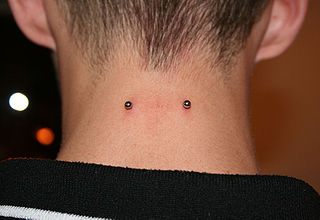
A nape piercing is a piercing through the surface of the nape of the neck. Nape piercings are a type of surface piercing. They carry a high rate of rejection and migration, unless they are properly measured and placed. They may reject if they are not pierced properly, as they are in a part of the body that moves constantly and are easy to irritate, catching on clothing or other objects.
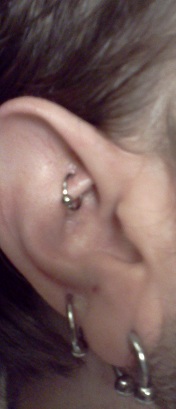
A rook piercing is a perforation of the antihelix of the ear for the purpose of wearing jewelry. It is located just above the tragus on the ridge between the inner and outer conch with the piercing passing from the underside to the top of this ridge, differing from many ear piercings that essentially span between a "front" and "back" surface. Erik Dakota, a well known professional piercer and the individual responsible for originating and popularizing the rook piercing, is said to have named this modification after a shortened version of his first name. The piercing was first named in issue #4 of the magazine Body Play and Modern Primitives Quarterly around 1992 alongside the first printed reference to the industrial piercing, then termed "industrial ear project".

Piercing migration is the process that occurs when a body piercing moves from its initial location. This process can be painful or go unnoticed, until it has progressed. Given enough time, a ring may migrate entirely outside of the skin, although it may only migrate a small amount and come to rest.

A corset piercing is a body piercing that consists of multiple piercings in rows, usually on the back, with ribbon or string laced through to mimic the appearance of a corset. Two rows of bilaterally symmetrical piercings are performed and can be composed of as few as four piercings or as many as the length of the area being pierced and the vertical space between piercings will allow space for. Due to the difficulty and risks associated with permanently healing single surface piercings, most corset piercings are intended to be temporary.
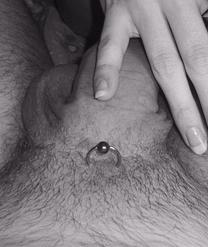
A pubic piercing is a body piercing in the pubic area. The term usually refers to a piercing at the base of the penis, making it a male analogue to the Christina. Healing times are typically around 3–4 months.. As this is essentially a surface piercing, the rejection rate is higher than most "conventional" piercings. Some get this piercing because it can offer direct stimulation to the clitoris during intercourse. Standard placement is horizontal, at the natural juncture where the bottom of the pubic mound meets the base of the penile shaft. Curved barbells are the most common initial jewellery, although a ring may be an option and many wearers replace their starting jewellery with rings once the piercing has healed. Piercings further up the pubis may also be possible, but this would not be a 'pubic piercing' as such but rather a surface piercing on the pubis. For these placements a staple-shaped surface bar would likely be used to give the best chance of healing.

A Madison piercing is a body piercing going through the skin at the front of the neck. They are surface piercings, and have a high rate of migration and rejection. They have a long healing period, if they heal at all. The Madison piercing is named after the first person publicly associated with it, the porn star Madison Stone.
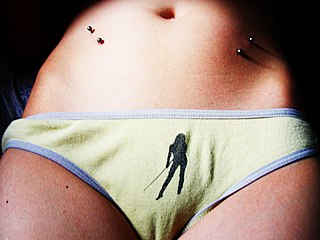
A hip piercing is a piercing in the pelvic area through the skin near the hip bone. Hip piercings are often done in couplets with one on each hip, but it is not unusual to see only one. Hips piercing are a type of surface piercing. Microdermals or skin divers can be implanted in the hip area to give a similar appearance.

In body modification, an implant is a device that is placed under the human skin for decorative purposes. Such implants may be subdermal or transdermal. In the context of body modification, some may consider injections of silicone and other substances a type of implant as well.
A cartilage piercing can refer to any area of cartilage on the body with a perforation created for the purpose of wearing jewelry. The two most common areas with cartilage piercings are the ear and the nose. Outside of the body modification community, many people commonly refer to a helix piercing as a "cartilage piercing." The cartilage ear piercing is known to be more sore than the lobe as in the cartilage there is less blood so it takes longer to heal.
A wrist piercing is a piercing through the surface of the wrist, first popularized by Jon Cobb in PFIQ. Wrist piercings are a type of surface piercing. They carry a high rate of rejection and migration, unless they are properly measured and placed. The piercings may be rejected if they are not installed properly; due to the location of the piercings they are easy to irritate, and regularly catch onto clothing or other objects. People with wrist piercings are advised to put on short sleeved t-shirts, singlets so as to prevent the surface barbell from catching onto the threads of the clothing. Also, wrist piercings can only be done with a special tool and thus, it is of high difficulty for it to be home-made. Piercers would also advise that, after getting a wrist piercing, the person is to soak and moisten the wound with mild salted solution so as to disinfect the area, preventing bacteria from entering the unclotted wound. The span of a wrist piercing ranges approximately from as short as 2 weeks to 6 or 7 months.

















